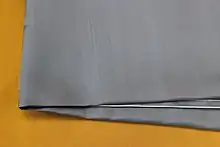Cuprammonium rayon
Cuprammonium rayon is a rayon fiber made from cellulose dissolved in cuprammonium solution.[1]

It is produced by making cellulose a soluble compound by combining it with copper and ammonia. The solution of this material in caustic soda is passed through a spinneret and the cellulose is regenerated in hardening baths that remove the copper and ammonia and neutralize the caustic soda. Cuprammonium rayon is usually made in fine filaments that are used in lightweight summer dresses and blouses, sometimes in combination with cotton to make textured fabrics with slubbed, uneven surfaces.[2]
The fabric is commonly known by the trade name "Bemberg", owned by the J.P. Bemberg company. The fabric may also be known as "cupro" or "cupra". It is also known as "ammonia silk" on Chinese fashion retail websites.
History
Cuprammonium rayon was invented in 1890.[3]
Properties
There are many properties of cuprammonium rayon:
- The fibers are very fine[4]
- It has a soft, silk-like handle (i.e., tactile feel)[4]
- It has similar properties to cotton. It is different in that the average degree of polymerization is lower and a larger part of this fiber is occupied by amorphous regions, causing cuprammonium rayon to swell more[4]
- It burns rapidly and chars at 180°C[4]
- On ignition, it leaves behind ash containing copper[4]
- It can be used to create fabric that is sheer and lightweight and has desirable draping properties[3]
Production
Cellulose is dissolved in [Cu(NH3)4](OH)2 solution and then regenerated as rayon when extruded into sulfuric acid.
References
- "cuprammonium rayon". Retrieved December 1, 2011.
- "Rayon Fiber". Archived from the original on April 6, 2008. Retrieved December 1, 2011.
- Davidson, Michael W. "Cuprammonium Rayon Fibers". Polarized Light Microscopy Digital Image Gallery. The Florida State University. Retrieved 2 July 2020.
- "Properties of Cuprammonium Rayon". 2009-05-15. Retrieved December 1, 2011.